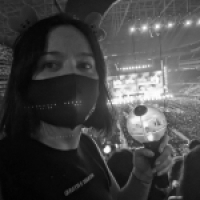How Birds of Prey Subverts the Male Gaze
We talked to Birds of Prey director Cathy Yan, screenwriter Christina Hodson, and star Margot Robbie about their female-driven action flick.
When the first image of Margot Robbie as Harley Quinn in Birds of Prey was released, Vanity Fair writer Joanna Robinson tweeted the photo alongside a promotional image of Robbie as Harley in Suicide Squad, writing: “I can’t always exactly explain the different between the male and female gaze, but I do know it when I see it.” The tweet went viral, obvously striking a chord with viewers who are sick of seeing girls and women objectified by the camera in the same boring ways.
As most of our commercial film history has seen predominantly men in positions of creative control, our film language has been shaped by the “male gaze,” a term film theorist Laura Mulvey coined in 1975. It sinks into so much of our film language. But it’s not all that there is and, as more women are given positions of creative authority behind the camera—even in genres like “action,” which have traditionally, lazily been categorized as predominantly of interest to men—we are, slowly, beginning to see more examples of what else is possible. Birds of Prey is one such movie.
The origin of the Birds of Prey film has already become part of its marketing narrative: Margot Robbie came up with the idea for a Harley Quinn spinoff while she was filming Suicide Squad (written and directed by David Ayer) and made it happen, acting as a producer on the film and securing both a female director (Cathy Yan) and female scriptwriter (Christina Hodson) for the project, which is not Harley-specific but rather features an ensemble of women, including Huntress (Mary Elizabeth Winstead), Black Canary (Jurnee Smollett-Bell), Renee Montoya (Rosie Perez), and Cassandra Cain (Ella Jay Basco). The crafting of an action film that subverts the male gaze happened organically from there.
“I don’t think we were really trying to react to anything specifically,” Yan tells Den of Geek during a Birds of Prey press junket in London. “And it’s interesting because we actually had male camera operators, so it’s not black-and-white, it’s not completely based on gender.”
For Yan, it wasn’t about actively subverting the male gaze so much as making sure that the girls and women in the film were comfortable and empowering them to do their best work.
“It was so fun creating the costumes for them, too, because it was done in such a way where it was more like dress up,” says Yan. “‘This looks cute. This is fun. I like this. How do you feel in that? Are you comfortable? Do you feel good? Do you feel sexy? Do you feel empowered? Is this flattering on you?'”
The female lens can be visual, of course, but it can also be narrative. One of the most refreshing aspects of the movie for this viewer was seeing a female-driven action film in which the women had positive, supportive relationships with one another, often taking the time to compliment one another in small and big ways.
While this is very much reflective of my lived experience of a woman with female friends and support networks, it has not often been represented on screen in some of my favorite genres, aka action and science fiction, which are usually considered primarily of interest to men. The films that have enough female characters for their to be a relationship between them (i.e. more than one) often depict those relationships as competitive, catty, and contentious—which, again, has mostly not been my experience of female relationships in real life.
Screenwriter Hodson noted that this interest in more realistic female relationships was part of Robbie’s initial pitch.
“One of the first things you said to me, is that you wanted to see real life female relationships on screen,” says Hodson. “That’s when I knew. I was like, ‘Yes. I’m in.'”
“It’s so ridiculous that there’s this idea that there’s this competition, or judgment, or whatever [between women],” says Robbie. “Honestly, every time we step out to do press together, the first thing we see is like, ‘Hey. Love this. Love the pants. Love that. Necklace is cool.’ It’s just what you do. We wanted all those small things to be recreated wherever possible.”
The result is something that (somewhat depressingly) feels radical: an action film featuring a diverse group of women that, while intentionally outlandish in some of its narrative elements, is more representative of the female experience than most films that have come before. It’s also a hell of a lot of fun—a movie for people of any gender who love a good fight scene and who are looking for something novel.
Birds of Prey hits theaters on February 7th. Find out more about the film here.
Kayti Burt is a staff editor covering books, TV, movies, and fan culture at Den of Geek. Read more of her work here or follow her on Twitter @kaytiburt.
